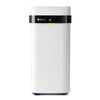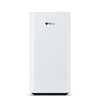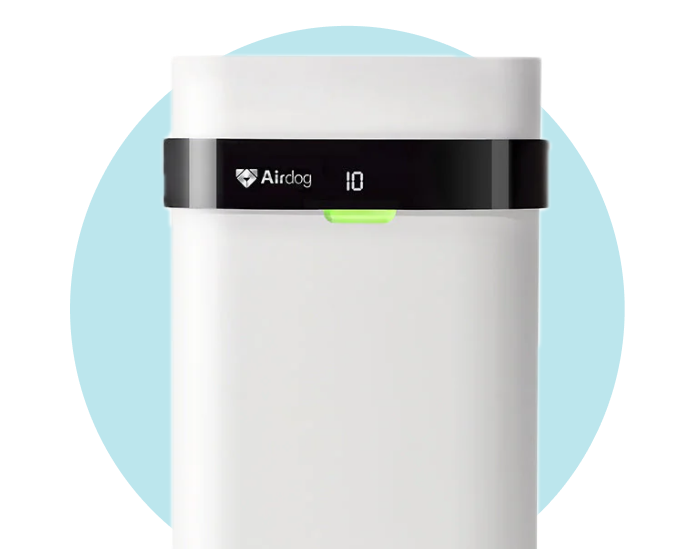When it comes to improving indoor air quality, two devices often come up in the conversation: the air ionizer vs air purifier. At first glance, they may seem similar since both aim to clean the air you breathe. However, they work in very different ways. Air purifiers typically use physical filters, like HEPA or activated carbon, to capture particles and pollutants. Air ionizers, on the other hand, release charged ions that cause airborne particles to clump together and fall from the air. Understanding these differences is essential if you want to choose the right solution for your home. In this article, we’ll break down how each technology works, compare their effectiveness, and help you decide which one is the better fit for your needs.
Unveiling the Air-Cleaning Technologies: Air Ionizer vs Air Purifier
When it comes to improving indoor air quality, air ionizers and air purifiers represent two of the most common solutions on the market. Both aim to reduce airborne pollutants, but they work in very different ways. These differences directly impact their effectiveness, safety, and suitability for different home environments. Understanding how each one works is key to making the right choice for your health and living space.
-
Air Ionizers: These devices operate by releasing negatively charged ions into the air. These ions attract positively charged particles such as dust, pollen, and smoke, causing them to clump together and settle out of the air. While ionizers can be effective against smaller particles, they have limitations when it comes to capturing larger pollutants. Moreover, a notable concern with ionizers is their potential to produce ozone, a harmful lung irritant, as a byproduct.
-
Air Purifiers: By contrast, air purifiers physically capture pollutants using filters. The most common type is the High-Efficiency Particulate Air (HEPA) filter, widely recognized as the standard in consumer air purification. These filters are designed to capture particles down to 0.3 microns, including dust, pollen, and pet dander. While HEPA filters remain the benchmark technology, newer systems are emerging that go beyond trapping particles, offering reusable or more specialized solutions. Importantly, unlike many ionizers, traditional air purifiers do not release ozone, making them a safer choice for most households.
The EPA notes that the effectiveness of any air-cleaning device depends largely on the type and size of pollutants in the air. With this in mind, choosing between an air ionizer vs air purifier isn’t simply about preference—it’s about aligning the technology with your specific indoor air needs and health priorities.
Understanding Air Ionizers
Air ionizers represent a unique approach to cleaning the air inside our homes. Unlike traditional air purifiers that rely on physical filters to trap pollutants, air ionizers use a fascinating method involving electrical charges to improve indoor air quality. Let's explore the mechanics behind air ionizers, their effectiveness against various types of particles, and discuss some of the concerns associated with their use, particularly the production of ozone.
The Mechanics of Air Ionizers
Air ionizers operate by generating a stream of negatively charged ions into the surrounding air. These negatively charged ions attach themselves to airborne particles, which are typically positively charged. This bond between negative and positive charges alters the physical properties of these particles, causing them to become heavier and subsequently settle out of the air. The process targets a variety of airborne contaminants, including:
-
Dust
-
Pollen
-
Smoke particles
By relying on electrical charges rather than physical filters, ionizers provide a distinct approach to air cleaning.
Effectiveness Against Different Particles
While air ionizers offer a novel approach to air purification, their effectiveness varies significantly depending on the size and type of particles they encounter. Here’s a closer look:
-
Small Particles: Air ionizers excel at attracting smaller particles, such as those found in smoke and certain types of bacteria. By binding to these microscopic contaminants, ionizers can effectively reduce their concentration in the air.
-
Larger Particles: The limitations of air ionizers become apparent when dealing with larger particles, such as dust and pollen. These particles are often too heavy to remain airborne for long periods, making them less likely to interact with the charged ions produced by the ionizer. As a result, ionizers are less effective at reducing the concentration of these larger particles in indoor environments.
Ozone Generation and Health Implications
One of the most significant concerns associated with air ionizers is their potential to generate ozone as a byproduct. Ozone is a powerful oxidant that, while beneficial in the upper atmosphere, can have detrimental effects on indoor air quality and human health when present in significant amounts at ground level. Exposure to ozone can exacerbate allergies, asthma, and other respiratory conditions.
Key considerations include:
-
Health risks: Ozone can irritate the throat and lungs, leading to coughing, discomfort, and exacerbated asthma symptoms.
-
Regulation: Air-cleaning devices that emit ozone are closely monitored, as unsafe levels can pose risks—especially in poorly ventilated spaces.
-
Effectiveness vs. Safety: Although ionizers can reduce certain airborne pollutants, the tradeoff is the potential introduction of harmful ozone indoors.
The Bottom Line
Air ionizers provide an innovative, filter-free way to target specific airborne contaminants. However, their limited effectiveness against larger particles and the risks tied to ozone generation mean they may not be the best fit for every home. Understanding your air quality needs and weighing safety alongside performance is essential before choosing an ionizer.
Exploring Air Purifiers
Air purifiers offer one of the most trusted ways to improve indoor air quality. Unlike ionizers, which depend on electrical charges, purifiers physically remove pollutants from the air. They come in different designs, each with its own method of capturing or neutralizing contaminants. Let’s look at how they work and what makes them effective.
Common Filtration Methods
Air purifiers can use a variety of filter types or purification systems:
-
High-Efficiency Particulate Air (HEPA) filters: Many models use high-density filters to capture fine particles such as dust, pollen, and dander. HEPA filters are the most recognized in this category. Other filter media can also provide similar particle-trapping benefits without carrying the HEPA label.
-
Activated Carbon Filters: Especially useful for removing odors, gases, and VOCs (volatile organic compounds), carbon filters are often paired with other filtration methods for broader coverage.
-
Advanced filtration technologies: Some purifiers rely on innovative designs that go beyond traditional filters, such as washable collection plates, electrostatic precipitation, or proprietary systems that combine multiple processes for higher efficiency.
-
UV-C Light Technology: A supplemental option in certain purifiers, UV-C targets microorganisms like bacteria and viruses by disrupting their DNA and rendering them inactive.
Safety: No Ozone Production
A critical advantage of air purifiers over ionizers is their safety profile, particularly concerning ozone production.
-
Ozone-Free Operation: Unlike some air ionizers that may produce ozone—a lung irritant harmful to human health—air purifiers that use filtration-based or hybrid technologies do not generate ozone. This makes air purifiers a safer choice for improving indoor air quality without introducing new health risks.
-
Regulatory Compliance: Most consumer-grade purifiers are also built to meet strict safety standards, ensuring that they improve indoor air without unintended side effects.
The Bottom Line
By choosing the right combination of filtration methods whether that’s particle filters, carbon, UV-C, or newer proprietary technologies, you can tailor an air purifier to your specific needs. This flexibility makes purifiers a versatile and safe choice for households aiming to maintain cleaner, healthier air.
Comparative Analysis: Ionizers vs. Purifiers
When considering how best to improve indoor air quality, distinguishing between air ionizers and air purifiers is key. Each technology takes a different approach, and their effectiveness, safety, and overall suitability depend on the specific needs of your household.
Effectiveness Against Different Particle Sizes
-
Air Ionizers:
-
Most effective against very small particles such as smoke, bacteria, and certain viruses.
-
Use electrical charges to make airborne particles clump together and fall from the air, theoretically reducing what remains in the breathing zone.
-
Less effective with larger particles like dust and pollen, which are common allergens.
-
Air Purifiers:
-
Use filtration or other capture mechanisms to physically remove pollutants from the air. Many models employ high-density filters such as HEPA, while others use advanced filter media or proprietary washable systems to achieve similar results.
-
Effective across a wide range of pollutants, from fine particles like smoke and dander to larger ones like pollen and dust.
-
Often paired with activated carbon or similar media to absorb odors, gases, and VOCs, giving them a more comprehensive role in indoor air quality management.
Safety and Health Implications
-
Ozone Production by Ionizers:
-
A significant concern with ionizers is the potential for ozone generation as a byproduct.
-
Even at low levels, ozone is a lung irritant and can aggravate conditions such as asthma and allergies.
-
This raises concerns for households with children, older adults, or anyone with respiratory sensitivities.
-
Ozone-Free Operation of Air Purifiers:
-
Purifiers that rely on filtration methods (HEPA, carbon, washable or electrostatic plates, hybrid systems) do not produce ozone.
-
Because pollutants are captured rather than chemically altered, these devices avoid the risks associated with ozone exposure.
-
This makes them a safer option for long-term, everyday use.
Suitability for Various Air Quality Needs
-
Targeted Use: Ionizers may be considered when the primary concern is ultra-fine particles like smoke. However, their limited effectiveness against larger allergens and the risk of ozone production reduce their appeal as a general solution.
-
Comprehensive Management: Air purifiers, regardless of the specific filtration system they employ, are more versatile. They address a wider range of pollutants—from particulate allergens to gases and odors—while maintaining a safer operating profile.
For most households, air purifiers provide a more complete, ozone-free solution to managing indoor air quality.
Making the Right Choice for Your Home
Deciding between an air ionizer and an air purifier ultimately comes down to balancing effectiveness with safety. Ionizers may reduce some fine particles, but their limited impact on larger allergens and the potential risk of ozone make them a less comprehensive solution for most households. Air purifiers, by contrast, offer broader coverage, tackling dust, pollen, smoke, pet dander, and even odors all without introducing harmful byproducts into your living space.
If you’re looking for an option that combines safety with cutting-edge efficiency, consider a purifier that goes beyond traditional disposable HEPA filters. A system like Airdog actively captures and destroys ultrafine particles, bacteria, viruses, and VOCs without generating harmful ozone. This means you get powerful air cleaning while keeping your home safe for everyone, including children, pets, and those with respiratory sensitivities.
When it comes to creating a healthier home, an ozone-free air purifier—especially one designed for modern needs like Airdog—offers the most complete and reliable solution.




